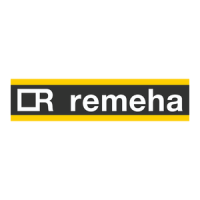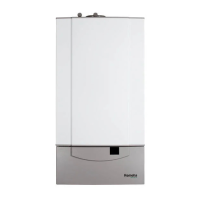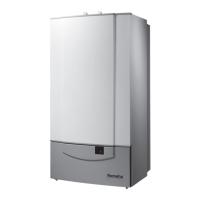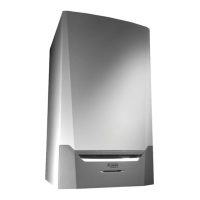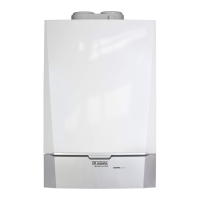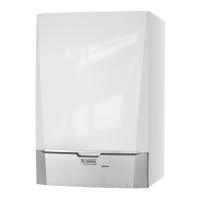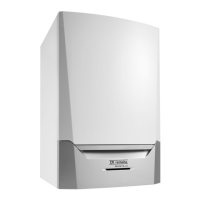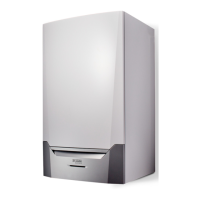What to do if the water pressure is too low in my REMEHA Boiler?
- LLuke BellAug 20, 2025
If the REMEHA Boiler's water pressure is too low, first verify the water pressure. Then, refill both the boiler and the entire installation with water.
What to do if the water pressure is too low in my REMEHA Boiler?
If the REMEHA Boiler's water pressure is too low, first verify the water pressure. Then, refill both the boiler and the entire installation with water.
What causes 5x flame loss in a REMEHA Boiler and how to fix it?
If your REMEHA Boiler experiences 5x flame loss, begin by venting the gas supply to remove any air. Ensure the gas valve is fully opened and verify the gas supply pressure. Check the operation and setting of the gas valve unit. Make sure the air supply inlet and flue gas outlet are not blocked and confirm that there is no recirculation of flue gases.
How to troubleshoot maximum flow temperature exceeded error in REMEHA Boiler?
If the maximum flow temperature is exceeded in your REMEHA Boiler, check the flow, including its direction, the pump, and the valves.
What causes low gas pressure in REMEHA Quinta Pro Boiler and how to resolve it?
If the gas pressure is too low in your REMEHA Boiler, ensure the gas valve is fully opened and check the gas supply pressure. Verify that the gas pressure switch (Gps) on the SCU PCB is correctly fitted. If necessary, replace the Gps switch.
What to do if maximum increase of the flow temperature has been exceeded in REMEHA Quinta Pro?
If the maximum increase of the flow temperature has been exceeded in your REMEHA Boiler, check the flow (direction, pump, valves). Also, check the water pressure, ensure the sensors are operating correctly and properly fitted, and verify the cleanliness of the heat exchanger.
What causes maximum difference between the flow and return temperature exceeded error in REMEHA Boiler?
If the maximum difference between the flow and return temperature is exceeded in your REMEHA Boiler, check the flow (direction, pump, valves). Also, check the water pressure, ensure the sensors are operating correctly and properly fitted, and verify the cleanliness of the heat exchanger.
What should I do if the difference between the flow and return temperatures is too great in my REMEHA Boiler?
If there is a difference between the flow and return temperatures that is too great in your REMEHA Boiler, replace the sensor if necessary and vent the central heating system. Check the flow (direction, pump, valves), the water pressure, and that the sensors are operating correctly and have been fitted properly. Check the cleanliness of the heat exchanger and that the heating pump is operating correctly. If present, check setting of boiler type parameter.
What causes a false flame signal in a REMEHA Quinta Pro Boiler and how can I fix it?
If a false flame signal occurs in your REMEHA Boiler, check the ionisation/ignition electrode. Inspect the gas valve, replacing it if necessary, and adjust the O₂/CO₂ settings.
What should I do if the phase and neutral of mains supply are mixed up in my REMEHA Boiler?
If the phase and neutral of the mains supply are mixed up in your REMEHA Boiler, invert the phase and neutral and set the parameter accordingly.
What does it mean when the blocking input is active on my REMEHA Quinta Pro Boiler and how do I resolve it?
If the blocking input is active on your REMEHA Boiler, remove the external cause, check the parameters, and inspect the wiring.
Essential safety guidelines for installers and users regarding gas and flue gas.
Advice on safe operation, installation, maintenance, and handling.
Outlines responsibilities of manufacturer, installer, and user regarding product use and maintenance.
Explains the meaning of symbols used to denote danger levels.
Lists and defines abbreviations used in the manual.
Details certifications, NOx class, and connection types for the boiler.
Presents key technical specifications like output, efficiency, and gas data.
Provides physical dimensions and port configurations for installation.
Illustrates the boiler's electrical wiring and component layout.
Outlines the Quinta Pro boiler's key properties and features.
Explains how the boiler functions, including pump and water flow.
Identifies and illustrates the main internal components of the boiler.
Details the function of control panel keys and display symbols.
Lists the items included in the standard boiler package.
Mentions available optional accessories for the boiler.
Specifies mandatory regulations and installer qualifications for installation.
Provides guidelines for selecting a suitable installation site for the boiler.
Describes the information found on the boiler's type plate.
Details requirements for the boiler's physical placement and installation space.
Outlines ventilation standards and compliance requirements.
States that installation must be done by qualified installers according to regulations.
Covers the initial steps for preparing the boiler and wall for mounting.
Details how to mount the boiler using the provided bracket and template.
Guides on connecting the boiler to the central heating and DHW systems.
Emphasizes the importance of cleaning and flushing the system before connection.
Step-by-step instructions for connecting the flow and return pipes.
Details on how to connect the expansion vessel to the system.
Instructions for correctly connecting the condensate drain.
Provides instructions for safely connecting the gas supply to the boiler.
Introduces flue gas connection types and classifications.
Details different flue gas connection types (e.g., C13, C33).
Lists manufacturers for drain systems and discusses outlet kits.
Provides guidelines on maximum chimney lengths and pipe reductions.
Offers further advice on installing flue gas and air supply materials.
Details assembly steps for flue gas and air supply connections.
Covers all aspects of electrical connections, from control units to optional PCBs.
Provides important connection values for the control unit.
Gives recommendations for making electrical connections safely and correctly.
Explains how to access and connect various components to the PCB.
Details how to connect the PWM pump to the standard PCB.
Discusses the PCBs installed and connection options for the 0-10 V PCB.
Details connections for external CH pump, three-way valve, and gas pressure switch.
Explains configuring rotary knobs for status messages on SCU-X01 PCB.
Provides instructions for filling the boiler and central heating system with water.
Advises on water quality and treatment for the heating system.
Details the procedure for dismantling, cleaning, and refitting the siphon.
Guides on filling the central heating system and checking for leaks.
Outlines steps to put the boiler into operation.
Details checks and procedures for the gas circuit.
Covers checks for the hydraulic circuit, including siphon and water connections.
Guides on checking electrical connections before commissioning.
Step-by-step guide for the initial commissioning of the boiler.
Covers gas settings, including adaptation to different gas types.
Instructions for adjusting the boiler for different gas types.
Details how to measure and adjust the O2/CO2 levels for optimal combustion.
Concludes commissioning with final checks and user instruction.
Explains how to use the control panel and interpret its displays.
Provides instructions for safely shutting down the boiler.
Details how the boiler's frost protection works and how to set it.
Lists and describes various parameters and their factory settings.
Guides on how to optimize boiler operation by adjusting parameters.
Guides on how users can modify parameters at the user level.
Details how installers can change parameters using an access code.
Explains how to set the maximum heat output for central heating.
Describes the process to reset the boiler to its original factory settings.
Explains the procedure for performing an auto-detect after PCB replacement.
Guides on how to set the boiler to manual operating mode.
Explains how to read current operational values from the control panel.
Details how to access and view various real-time boiler parameters.
Shows how to retrieve boiler operating hours and start success rates.
Lists and explains the various status and sub-status codes displayed by the boiler.
States that the boiler requires periodic inspection and maintenance.
Explains the automatic service message system for preventive maintenance.
Guides on how to reset the service message after maintenance.
Details how to initiate a new service interval for the boiler.
Lists routine inspection and maintenance tasks.
Describes how to check and maintain the correct water pressure in the system.
Explains how to check the ionisation current for burner operation.
Guides on checking flue gas and air supply connections for condition and tightness.
Details how to check combustion by measuring O2/CO2 in flue gases.
Instructions for checking the automatic air vent for leaks or proper function.
Details the procedure for dismantling, cleaning, and refitting the siphon.
Guides on checking the burner and cleaning the heat exchanger.
Covers specific maintenance tasks that may be required.
Provides instructions for replacing the ionisation/ignition electrode.
Details how to inspect and replace the non-return valve if defective.
Step-by-step guide for reassembling the boiler after maintenance.
Lists and explains error codes displayed by the boiler.
Explains boiler blocking modes and how to read blocking codes.
Describes boiler lockout states and how to interpret error codes.
Explains how the boiler stores and manages error history.
Guides on how to access and view stored error codes and related data.
Details the procedure for clearing error codes from the boiler's memory.
Provides step-by-step instructions for safely removing and disposing of the boiler.
Emphasizes using only original or recommended spare parts for replacements.
Illustrates and lists the spare parts for Quinta Pro 30-45 models.
Presents ErP information including energy efficiency class and heat output.
Provides key product data as per the ErP directive.
Details how to calculate the seasonal space heating energy efficiency of a package.
States compliance with European directives and availability of declaration.
Lists optional PCBs that can be purchased and installed.
Explains how to access the PCB housing for installing optional PCBs.
Details connections for gas pressure switch and heat recovery unit on SCU-S03.
Explains connecting 230 VAC or 24 VAC three-way valves to SCU-X02.
Describes controlling a modulating central heating pump via SCU-X03 PCB.
Mentions connection options for c-Mix PCB for heating groups and calorifiers.
| Type | Condensing Boiler |
|---|---|
| Installation | Wall-mounted |
| Heat Exchanger Material | Stainless Steel |
| Fuel Type | Natural Gas, Propane |
| Control | Compatible with various BMS systems |
| Warranty | 5-year limited warranty (heat exchanger) |
